BENJAMÍN CIEZA HURTADO EXHIBITS “SUBYUGADO” IN VIGIL GONZALES GALLERY
Set in Valle Sagrado de los Incas (Peru), the works are exhibited along with a made-for-the-occasion text written by Rafael Mayu Nolte. Taking its elements from banking, advertising and finance, the show aims to expose the ways in which a generation was manipulated and even suffocated by monetary schemes. Through metonimias and the deliberate invisibility of all identities but the white male, Cieza Hurtado speaks to the middle-class consciense of Lima.

Contacts and transactions | Rafael Mayu Nolte
Looking at the projects of Benjamín Cieza Hurtado (Lima, 1991) as a whole, one can trace a thematic line: the concern for the elements that have built an everyday visuality of Lima’s middle class. Related to a recent current of pictorial realism in Lima, his is, nevertheless, a personal look guided by emotion and day-to-day concerns. One that gathers images and their qualities with which we, his contemporaries, can identify. While there is an emphasis on temporal dislocation, rather than a historicist zeal, there is a generational awareness. But other deviations begin to emerge from this line. Gradually, notions such as exchange, transaction and monetary presence have become predominant. This is not accidental.
Benjamin’s projects are delimited and concrete. Whether or not there is a diversity of media and pieces, each work presents an idea or a feeling that is magnified. In the series of paintings presented in his previous show, entitled Sigue Siendo Hoy (It Is Still Today) and exhibited in the viewing room of the Vigil Gonzales gallery, he precisely zoomed in on fragments of analog family photographs. The quality of the film, very recognizable for those who grew up in the nineties, reproduced and intensified through the pictorial medium, showed caricatures, fragments of home spaces, flowers and, decisively, the approach of pairs of people in invariably period clothing, in affectionate embrace. The bodies are not clear in their contact, and only sporadically hands or arms appear, in an attitude of care or affection.
-
Benjamín Cieza Hurtado - Sigue siendo Hoy IV - 2021 - De la serie Sigue siendo hoy - Óleo sobre tela - 35 x 50 cm
-
Benjamín Cieza Hurtado - Sigue siendo Hoy IV - 2021 - De la serie Sigue siendo hoy - Óleo sobre tela - 35 x 50 cm
-
Benjamín Cieza Hurtado - Sigue siendo Hoy IV - 2021 - De la serie Sigue siendo hoy - Óleo sobre tela - 35 x 50 cm
I focus with special care on Sigue siendo hoy because its nostalgic journey, traced with fragments ranging from the familiar embrace to abstraction, finds its reverse side in the artist’s new project, entitled Subyugado (Subjugated). In it, he succinctly reproduces graphic material from bank advertising, taken from a group of publications from the 1990s. The pictorial treatment is sparing and cold, delving into the formality of the images. With the text that accompanies each sheet removed, the works in the project are divided between a series of the same name as the title of the exhibition and two individual paintings. In Subyugado I, II and III, we are presented, respectively, with a handshake of two hands, a hand showing a credit card in an attitude of payment and a bank card over a wallet, together with some keys. Like all advertising photography, the images are clearly choreographed, the contact between the different elements planned down to the smallest detail, representing a very specific subject: the executive man.
-
Benjamín Cieza Hurtado - Subyugado I - De la serie Subyugados - 2021 - Oleo sobre lienzo - 80 x 90 cm
-
Benjamín Cieza Hurtado - Subyugado II - De la serie Subyugados - 2021 Oleo sobre lienzo - 80 x 70 cm
-
Benjamín Cieza Hurtado - Subyugado III ¬- De la serie Subyugados - 2021 Oleo sobre lienzo - 80 x 65 cm
What is the purpose of these images? It is a double game, between aspirations that are sought to arouse and to correspond; the search of the one who pursues that life, that status. This service is for people who close business deals, who pay for luxury items with their new platinum card, who only need their bank card to communicate who they are. In contrast to the disorganization and certain clandestinity of the works of Sigue Siendo Hoy, where spontaneity guides the contact between the bodies and the fragments of the home, the white hands here are firm, have a clear purpose, communicate a precise lifestyle. The contact between the different elements is transactional. We are still far from the popular capitalism that will seek to create the bank publicity of our youth, far from the attempts to appeal to the popular classes, to women, and to bend to a mestizo national discourse.
More than 20 years after their original publication, and with the suspicion that one acquires towards advertising, these images become time capsules that distort the intention of their creators. Rather than symbols of trust, status or progress, the characteristics of the hands and objects presented are shown as reminders of the relationship of Lima’s middle class with the financial system: one of suffocation. It is not that a banking system cannot be a catalyst of opportunities, it is that the generational experience of parents encircled by the day-today economy, of the bills to make ends meet, is imposed. A feeling that is reactivated today, exacerbated by the crisis, but also by ever-diminishing expectations of what the future holds. Faced with the prospect of a future in which we no longer have our own apartments, cars or stability, and where we have to work to pay the bills, debt is once again our present.
The central piece of Subyugado is titled Tú (You). It is an illustration taken to a very large scale. It shows a colossal, outstretched hand bridging a group of small people, mostly men in suits, at the junction between two cliffs. It was probably accompanied by a text that emphasized the facilitating character of that hand, as an avatar of the friendly banking institution, a help to reach your goals. Today, seeing Benjamin’s enlarged and isolated reproduction, that character is called into question. Tú, from its title, is immediately a questioning of the spectator’s position in this scheme, which generates uncertainty rather than trust.
-
Benjamín Cieza Hurtado - Tú - De la serie Subyugados - 2021 Oleo sobre lienzo - 85 x 190 cm
Benjamín Cieza Hurtado was born in Lima in 1991. He graduated in Painting at the Faculty of Art and Design of the Pontificia Universidad Católica del Perú. His work explores through domestic and urban visuality the elements that shape his identity and place in the city. Work, social mobility, affection and interpersonal relationships are processes that he is interested in recognizing as a fundamental part of his development and that of the other members of the society in which he finds himself. Recently his work has inquired about higher education and interpersonal relationships at the domestic space.
Subyugado
Until July, 23rd
VIGIL GONZALES gallery
Jr. Grau 654, Urubamba - Valle Sagrado de los Incas



